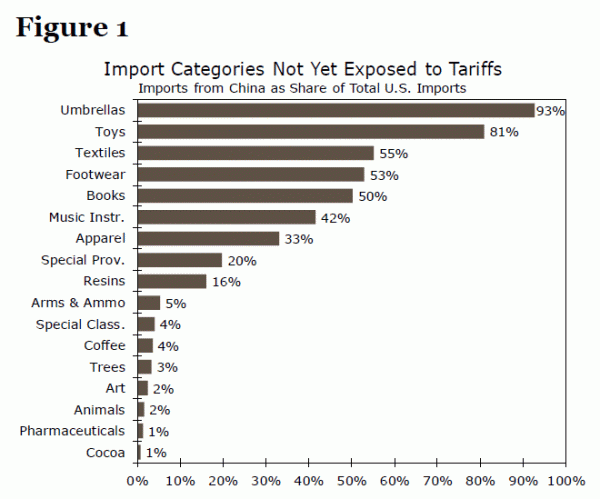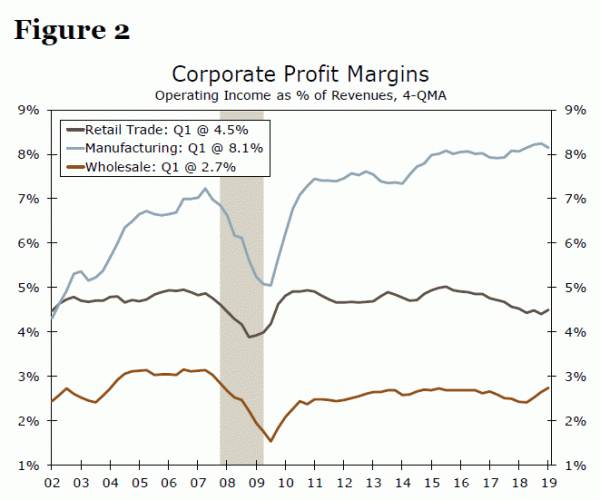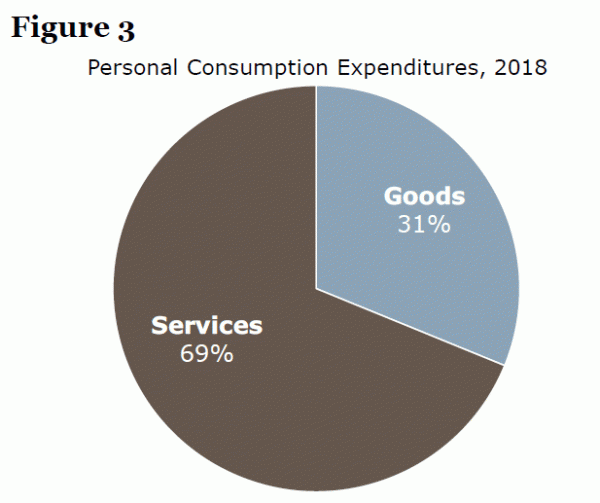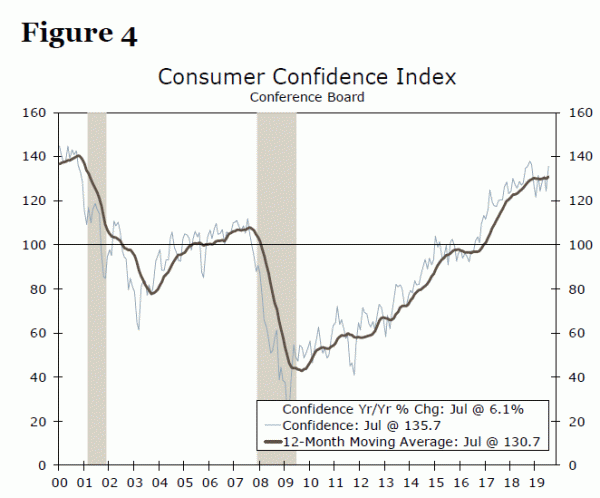Tariff Threat: What Is It This Time?
The recent escalation in the trade war involves levying a 10% tariff on an additional $300 billion worth of goods coming in from China. Predictably, this was met within hours by an announcement from China that “necessary countermeasures” would be pursued. It bears noting here that because the public comment period has already been observed, this is not an idle threat. The announced effective date of September 1 now becomes a realistic baseline expectation and we are adjusting our forecast accordingly. The higher prices that importers will pay means either higher prices for consumers or squeezed margins for businesses. Our bet is that consumer price inflation will rise slightly, and, although that will not derail consumer spending, the latest round of tariffs could weigh on confidence.
In earlier bouts in this trade fight, the impacted categories were further up the production pipeline, like steel and aluminum. The first $250 billion worth of goods subject to tariffs were mostly inputgoods from China. This new round impacts finished goods like toys, clothing and consumer electronics. Figure 1 shows major categories of imports according to the Harmonized Tariff Schedule that are now subject to tariffs under this latest round. Clothing, toys and footwear have not yet been exposed to tariffs, but imports from China represent anywhere from 33%-53% of total U.S. imports of these goods. Said differently, $28 billion of U.S. apparel, $27 billion of toys and $14 billion of footwear imports came from China last year. This more direct consumer exposure gives this round of tariffs the capacity to more meaningfully impact U.S. inflation and consumer spending than earlier rounds did.
Inflation Finally Unleashed? Not Quite
The extent to which the tariffs impact inflation will bear on a number of factors. If importers push back on costs from suppliers or the dollar strengthens, the impact would at the very least be mitigated. Suppliers may have little room to budge on their margins and/or contract prices may already have been set in, however. At the same time, Chinese authorities are likely reluctant to let their currency adjust downward too quickly. So that leaves U.S. firms with some decisions. Do they absorb the additional cost of tariffs, leaving them with lower margins and profits? Or do they pass tariff costs on to consumers?
In previous rounds aimed more at intermediate goods, tariffed inputs were only a part of a finished goods’ final costs. Now, with the full value of many finished goods subject to tariffs, there is less scope for businesses to absorb the additional cost. Retailers and wholesalers already operate under thinner margins than manufacturers (Figure 2). Therefore, we expect at least some of the tariffs that importers pay will be passed on to consumers via higher prices, as we have seen in previous rounds. Take furniture for example, where about half of all U.S. imports come from China. After falling for the better part of this century, prices have risen more than 3% over the past year, the biggest one-year jump since the mid-1990s.
How much of an increase to inflation might we see then? We estimate the latest round will add a little over 0.1 percentage point to the year-over-year rate of CPI inflation. That may seem small, but it is worth noting that goods make up only a fraction of the components that comprise the inflation basket. Specifically, about 75% of the core CPI is comprised of services, which are by and large insulated from tariffs. Goods account for the remaining quarter. In terms of the overall CPI, clothing accounts for 2.3%, footwear 0.7%, toys 0.2% and books 0.2%.
Caught in the Crossfire: Implications for Consumer Spending
The fact that higher prices for consumer goods might be lurking around the corner does not mean that consumer spending is going to crater because of the tariffs. If you add up all the money that a typical household spends on goods, it adds up to about a third of overall consumer spending (Figure 3). Higher costs will either lead to lower sales of these items, or squeeze wallet share for other spending, including services. It could also result in a lower saving rate as consumers are only able to stretch a paycheck so far.
Because the already-implemented tariffs targeted intermediate goods, they have so far (and by design) avoided directly impacting the typical U.S. consumer. The recent expansion hits a number of categories, which were not previously subject to these levies (refer back to Figure 1). This is part of the reason consumers have not been overly concerned about tariffs…at least so far.
Although consumer confidence has come off the boil from its cycle high back in October, it has remained historically high despite headlines about the trade war (Figure 4). That said, the fact that categories like apparel, footwear and toys make up a considerable share of the goods now subject to tariffs means that for the first time in this trade war, the tariffs could soon start getting in consumers’ heads. In normal (non-trade war) periods, we use the price of gasoline as a major input for our forecast model for confidence. We have found that even though it’s just 2% of spending, high gas prices weigh on confidence. Along the same line of thinking, higher prices for consumer goods could sap confidence just like pain at the pump and weigh on consumer spending.
It bears mentioning that a 10% tariff is substantially different from a 25% tariff. We have no official house view on how the trade war might escalate or de-escalate from here, but at 10% the likeliest outcome in our view is shift in the composition of spending as we have described with more money going to goods at the expense of services and/or saving. Yet after factoring in higher inflation, we could also reasonably expect slightly slower real PCE growth, unless consumers save less. This is another way of saying we would be spending more on the same volume of goods.
Does this Change the Fed’s Thinking?
The FOMC has clearly been worried about global headwinds to the outlook, particularly as it relates to trade policy. The latest escalation in the trade war gives more reason for the FOMC to be concerned about downside risks to the outlook, but the direct impact still looks to be manageable. Assuming inflation expectations do not become unmoored by this move (which seems reasonable considering expectations are near historic lows despite the tariffs initiated thus far), the boost to inflation will not only be small, but temporary since prices will experience a one-time level shift. Consumer spending power will be reduced, but the impact to the pace of spending should be fairly minimal. The indirect effects on business and consumer confidence, corporate profits and investment, however, give more reason to be concerned. With no end in sight to trade tensions, we suspect the FOMC is not finished with its “mid-cycle adjustment” quite yet.
Bottom Line
Shortly after stepping down from his role as President Trump’s Director of the National Economic Council, Gary Cohn said in an interview, “Tariffs don’t work. If anything, they hurt the economy because if you’re a typical American worker…you have to spend more on the necessity products that you need to live, you have less to spend on the services that you want to buy.”
The latest escalation in the trade war likely means that after so much effort in previous rounds to avoid collateral damage to consumer confidence and spending, consumers are now in the crossfire of the trade war. Higher prices alone may not derail consumer spending, but to the extent that higher prices get into consumers’ heads it could weigh on sentiment and eventually spending. Until and unless these trade tensions abate, we suspect the FOMC is not finished with its “mid-cycle adjustment” yet.
















